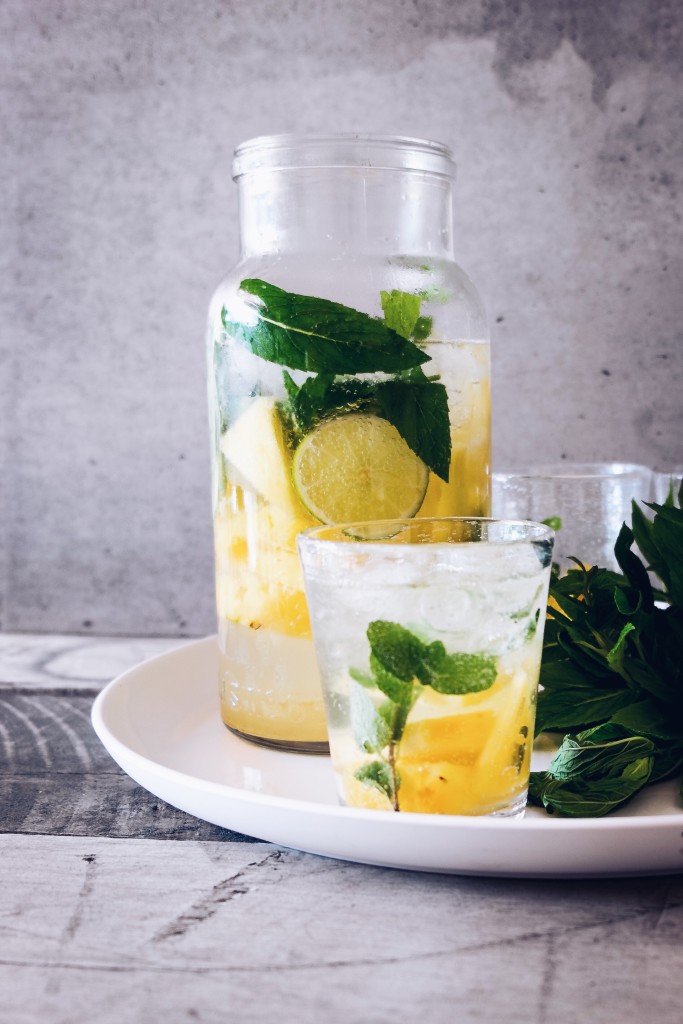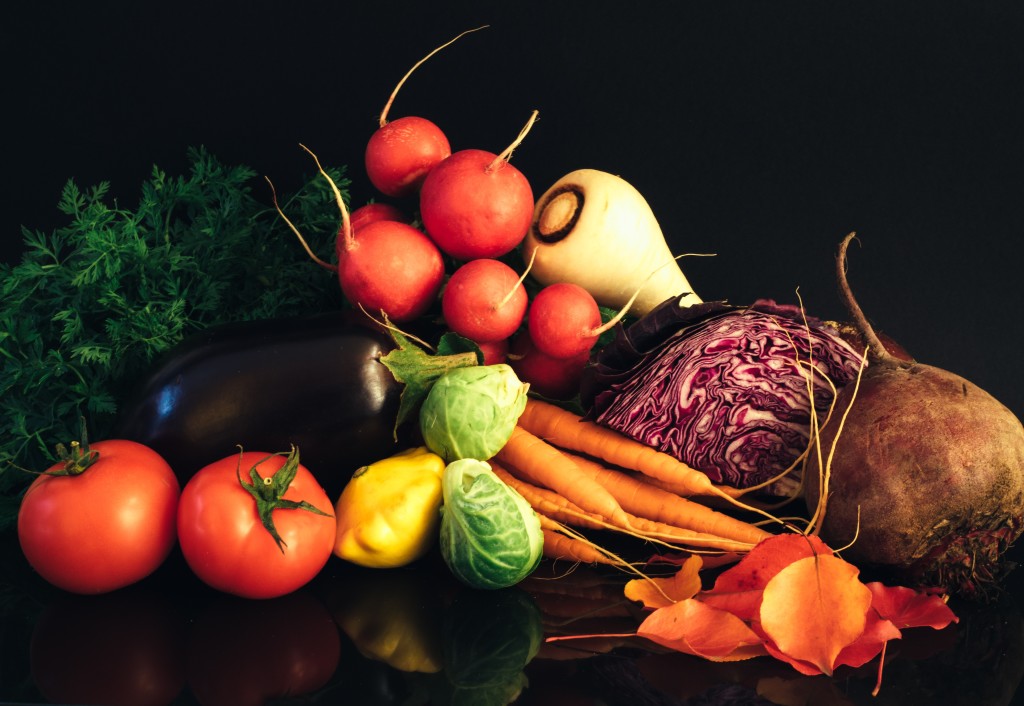Tags
acne aging anti-aging beauty detox diet exercise fasting healing health healthy lifestyle healthy living healthy recipes inspiration juicing Living la Vida Raw meditation mindfulness Move Your Body Natural Beauty natural cures Natural Cures natural remedies nutrition nutritionist parasites raw raw food Raw Food for Thought raw foods raw girl Raw News raw recipes Raw Spirit Recipes skin spirulina stress vegan vegan lifestyle vegan recipes vegetarian Veggie Love wellness yogaNewsletter Sign-up
Tag Archives: vegan
Summer Nutrition: 10 Foods That Help to Beat the Heat
 Summer is finally here and it’s a great time to break out the sunscreen and also change our diets to suit the season. In the summer we generally are outdoors more often, so we need to consider the effects of the heat and our bodies’ need for more hydration. Remember the very general rule of thumb is to consume in fluid ounces around half of your body weight in water, but if you are very active, and also outside more often during the summer I would increase your requirements, not to exceed around 125 fluid ounces. Don’t forget you can also boost your hydration using food! I personally love to be high, if not 100% raw during this summer season because the lighter, more water-rich the better I feel. Every person is unique, so it’s important that you find what works for your body. Because most of us get our produce in grocery stores, it can be very difficult to know what is in season. This is a great time to get out and venture to a local farmer market to try some new fruit or veg, heavier on the fruit. Below are a few of my summer, summertime favorites that will help you to stay cool during beach season. – Xo Raw Girl
Summer is finally here and it’s a great time to break out the sunscreen and also change our diets to suit the season. In the summer we generally are outdoors more often, so we need to consider the effects of the heat and our bodies’ need for more hydration. Remember the very general rule of thumb is to consume in fluid ounces around half of your body weight in water, but if you are very active, and also outside more often during the summer I would increase your requirements, not to exceed around 125 fluid ounces. Don’t forget you can also boost your hydration using food! I personally love to be high, if not 100% raw during this summer season because the lighter, more water-rich the better I feel. Every person is unique, so it’s important that you find what works for your body. Because most of us get our produce in grocery stores, it can be very difficult to know what is in season. This is a great time to get out and venture to a local farmer market to try some new fruit or veg, heavier on the fruit. Below are a few of my summer, summertime favorites that will help you to stay cool during beach season. – Xo Raw Girl
- Watermelon – I love my watermelon in the summer and it’s the perfect refreshing and cooling treat when the heat gets too much. There are many ways to skin a watermelon so don’t get bored by just eating it straight. Try squeezing lime and a pinch of sea salt over your watermelon, or blending in into a summer cocktail with some fresh basil or mint.
- Citrus – Oranges, grapefruit, tangerines oh my! Citrus is an excellent source of vitamin C and research has indicated that consuming foods rich in vitamin C may help to reduce body temperature or just cope with the heat more productively.
- Squash – High in water content, and abundant at local farms in the summer, squash can be a versatile addition to summer nutrition. Try Zucchini noodles anyone? You can also add them to salads and lightly steam them. After steaming, freeze some of the zucchini and add to smoothies to boost the nutrition in your morning shake. Trust me, you won’t even know it’s in there.
- Celery & Fennel – Celery is one of my favorite additions to my daily juices in the summer. Celery also contains a healthy amount of sodium, and is a great juice to drink to maintain electrolyte balance. Fennel is a super delicious addition to salads and also can be juiced. Both celery and fennel are diuretics, which promote the formation of urine in the kidney.
- Cantaloupe and Honeydew Melon – Both melons have high water content, are diuretics, and can be a refreshing addition to a summer fruit salad.
- Apricots, Peaches, Nectarines – Nectarines and apricots are sweet, juicy, and lovely to carry around as on-the-go snacks in the summer. Both are rich in vitamin A and the antioxidant beta carotene.
- Cucumbers – Up there in the all time favorites for addition to veggie juice in the summer, cucumbers are rich in water content and generally refreshing. Juice it, add it to your salads, and when you have left overs put a few over your eyes to reduce puffiness and relax.
- Coconuts/ Coconut Water – Another amazingly hydrating food, coconuts are excellent for hydration, and coconut water is a great natural source of electrolytes. I love to add coconut water and meat to smoothies in the summer, or even better just eat them plain.
- Radishes – You may usually avoid the radishes when perusing the veggies at your local grocery store, but during the summer you may want to pick some up. Radishes are high in water content, somewhere around 95%, rich in vitamin C and add a nice kick to salads.
- Pomegranates – Rich in antioxidants, vitamin K, vitamin C, folate, potassium and fiber, pomegranates are the bomb.com when it comes to a dense nutrient profile. You can drink pomegranate juice (beware of added sugars) or add the seeds to your salads for a colorful and flavorful summer meal.
References:
Strydom NB, Kotze HF, van der Walt WH, Rogers GG. Effect of ascorbic acid on
rate of heat acclimatization. J Appl Physiol. 1976 Aug;41(2):202-5. PubMed PMID:
956103.
5 Reasons to Drink Green Tea
When it comes to tea, it’s safe to say that green tea is one of the most researched cups out there, probably because it has been used for medicinal purposes in China and Japan for thousands of years. If you are weaning yourself off of coffee, green tea can be an excellent addition to your routine because it does contain some caffeine, but less than coffee, and also includes some additional health benefits that’ll make that morning cup seem oh so worth it! Green tea comes from the same plant as black and oolong teas, but is lightly steamed in preparation. Because it is not as processed, green tea contains a rich supply of catechins, which are antioxidants that can help to reduce and prevent cell damage. Research has show that one of green tea’s components ECCG, has potential protective effects against heart disease and cancer. In addition to this, green tea contains numerous phytochemicals that may help improve memory and cognition, powerful antioxidants that may decrease oxidative damage to the mitochondria in the brain, and it may also assist in relieving digestive symptoms and headaches. Research has shown that, aside from helping to prevent cancer and heart disease, green tea offers protection from the development of Parkinson’s disease, Alzheimer’s disease, and other brain disorders.
Although green tea has not been proven to be the answer when you are looking to drop a few pounds, the tannins and polyphenols of green tea do help the body regulate insulin sensitivity while helping the brain maintain a steady supply of glucose. This can also assist to regulate energy, mood swings, and help maintain a positive outlook during the day. While green tea contains less caffeine than coffee, it may still contain more caffeine than some can tolerate so listen to your body and adjust accordingly. If the caffeine is too much for you, try getting rid of the first steeping of the tea bag and steep again using the same tea bag, or drink decaffeinated green tea instead. Want the health benefits but find green tea too bitter for you to taste? Try using cooled green tea instead of water or juice when you make your morning smoothie. Brewed green tea can also be poured over cooked brown rice and topped with vegetables like seaweed or other greens. In the summer to beat the heat, try iced green tea in summer with some lemon juice topped with a mint leaf.
If possible, try to consume green tea without added sugar. If you must sweeten it, try using an alternative to refined sugar like coconut sugar, xylitol, or stevia. Consuming foods or drinks that are bitter is exceptionally good for your digestion and curbing sugar cravings, so if you can brave it I recommend drinking it straight up. -Xo Raw Girl
References:
- Boehm K, Borrelli F, Ernst E, et al. Green tea (Camellia sinensis) for the prevention of cancer. Cochrane Database of Systematic Reviews. 2009;(3):CD005004 [edited 2010]. Accessed at http://www.thecochranelibrary.com (link is external) on July 16, 2015.
- Green tea. Natural Medicines Web site. Accessed at naturalmedicines.therapeuticresearch.com/ on July 16, 2015. [Database subscription].
- Hartley L, Flowers N, Holmes J, et al. Green and black tea for the primary prevention of cardiovascular disease. Cochrane Database of Systematic Reviews. 2013;(6):CD009934. Accessed at http://www.thecochranelibrary.com (link is external) on July 16, 2015.
- Jurgens TM, Whelan AM, Lillian L, et al. Green tea for weight loss and weight maintenance in overweight or obese adults. Cochrane Database of Systematic Reviews. 2012;(12):CD008650. Accessed at http://www.thecochranelibrary.com (link is external) on July 16, 2015.
- Scott, P. S. (n.d.). Health Benefits of Green Tea. Retrieved July 12, 2018, from https://www.webmd.com/food-recipes/features/health-benefits-of-green-tea#1
7 Nutritional Imbalances That Contribute to Depression
 We’ve all had bad days. But after really talking to someone with diagnosed major depressive disorder I realized that even on my worst day I probably have never experienced the depth of what depressed folks struggle with. The closest I’ve come to experiencing it has been when coping with loss of loved ones to death. Given the high profile suicides in the media lately, I think we all can agree that all that glitters isn’t gold, and that even if and when we attain certain levels of material success, it is possible to feel empty inside. One thing I do know for sure is that no matter where you are on the spectrum from feeling meh, to literally contemplating ending your life your feelings should never be disregarded or ignored. Depression can come in several forms and differing levels of severity: it can be in response to an external stimulus like a death in the family or job loss, or it can be this overarching mood that doesn’t seem to improve, perhaps without explanation.
We’ve all had bad days. But after really talking to someone with diagnosed major depressive disorder I realized that even on my worst day I probably have never experienced the depth of what depressed folks struggle with. The closest I’ve come to experiencing it has been when coping with loss of loved ones to death. Given the high profile suicides in the media lately, I think we all can agree that all that glitters isn’t gold, and that even if and when we attain certain levels of material success, it is possible to feel empty inside. One thing I do know for sure is that no matter where you are on the spectrum from feeling meh, to literally contemplating ending your life your feelings should never be disregarded or ignored. Depression can come in several forms and differing levels of severity: it can be in response to an external stimulus like a death in the family or job loss, or it can be this overarching mood that doesn’t seem to improve, perhaps without explanation.
What I’ve learned as I deepened my studies of nutrition is that poor diet, lack of supplementation, and nutrient deficiencies can play a HUGE role in depression. In fact, I wish more people knew about the nutrition – depression connection because perhaps more would consider seeing a therapist and a nutritionist to help them cope and heal. In a world where people were woke to this fact, when someone was dealing with depression maybe their doctor would refer them to a nutritionist, or psychiatrists would send clients for micro-nutrient testing before prescribing antidepressants. This article provides a very broad overview of a few imbalances you can look for or speak to your practitioner about if you think you may be depressed or are already diagnosed.
Some of the major nutritional imbalances that can lead to depression can include:
- Imbalance of gut flora – The health of our gut is incredibly essential for overall health and well-being, but most of us have no idea that the health of our gut is also tied to our mental health. The gut-brain axis shows us that there is a link of communication happening between our gut and brain and that it goes both ways. Meaning, if your gut is imbalanced, or there is a lack of good bacteria, intestinal overgrowth, parasites, etc. this gets communicated to the brain and effects your mood. What can you do about this? Well if you have complex gut related issues you need to consult with a health practitioner to address the underlying cause and health the gut. If you have eczema, psoriasis or other skin related issues, you may have an issue with leaky gut, and need to begin a protocol to health the gut, which can in turn improve your mood. For general maintenance, taking a good daily probiotic and including fermented foods with meals at least 2-3 times a week can help. Some good sources of probiotics include: kimchi, sauerkraut, kombucha, Rejuvelac, or homemade yogurt (store-bought can be too processed and have high sugar content).
- Low omega-3 fatty acids – Multiple research studies have found a clear association between low blood levels of EPA and DHA and an increased risk of depression, violence and suicide. Epidemiologic studies have found a clear correlation between a low intake of EPA and DHA and the prevalence of depression. In two studies of population groups in the USA the incidence of depression was found to be 3.7% and 2.9%. Average intake of EPA and DHA in the USA is estimated to be about 0.1 gram per day. In two Japanese studies, on the other hand, the incidence of depression was only 0.9% and 0% and the intake of EPA plus DHA was 1.5 grams per day and 4.2 grams/day respectively. To ensure you are getting adequate omega-3 fatty acids you can include and daily supplement and increase your intake of omega-3 rich plant foods: walnuts, chia, hemp seeds, Flax seeds, avocado. For plant-eaters a good algae based supplement that includes both DHA and EPA is essential. If you are a meat eater: incorporate cold water fatty fish like salmon and consider taking a fish oil. If you are pregnant or planning pregnancy, omega-3 fatty acids are incredibly important to supplement and consume for the babies’ brain health and to prevent postpartum depression after giving birth.
- Low folate – Folate is a water soluble B vitamin that cannot be stored in the body and much be obtained through our diet. Men and women over 18 generally need around 400 micrograms per day of folate, and pregnant women need 600 mcg. In some research studies, individuals with depression have been shown to have low folate levels, which is also known as vitamin B9 [1]. Some good food sources of folate include: edamame, okra, spinach, artichoke, lettuce, turnip greens, asparagus, endive (raw), Brussels sprouts, legumes, beets (cooked).
- Low intake of B vitamins – B12, Niacin, Folate (as mentioned above) etc. – Besides Vitamin B-12 being number one on the must supplement list for plant-eaters, it may also play a role in getting your mind right if you are depressed or experience low moods. This is because B12 and other B vitamins play a role in producing brain chemicals that affect mood and other brain functions and low levels may be linked to depression. For plant-eaters, especially those who are vegan or cut out all animal products, please get a good daily multivitamin with vitamin B12 included, ideally in the methylcobalamin form which is easily absorbed by the body. If your multi or B12 supplement includes cyanocobalamin I recommend switching that out for a new brand. Besides a supplement, using nutritional yeast helps a lot to increase your intake of B vitamins. I tend to sprinkle nutritional yeast on everything: salads, soups, even steam sauteed veg for added nutritional value.
- Low iron – If you are anemic, or have a history or low iron levels in your blood work, this can also contribute to depression. If you are experiencing fatigue, irritability, and brain fog along with depression make sure you have your iron levels tested. Iron supplements can often cause constipation, so it’s important not to supplement if your levels are normal when you get labs, and better to increase intake of iron-rich foods if your levels are low. Some plant food sources of iron include: legumes, tofu (go for non-GMO), spirulina, cacao, nuts and seeds, leafy greens, blackstrap molasses, quinoa.
- Low Zinc – If you missed it, check out my last post on Zinc and why deficiency is so common in adults. Inadequate intake of zinc can play a role in depression because zinc plays a part in modulating the brain and body’s response to stress. Research studies have found that zinc is low in the serum of those suffering from depression. In fact, the more depressed someone is, the lower their zinc level in some cases.
- Other Notable Imbalances: Vitamin D, and Magnesium. Vitamin D is not a vitamin, it’s actually a hormone and is incredibly essential for our immunity and disease prevention overall. Ideally we should all get around 2000 IU per day; so you can find a multivitamin with that amount of vitamin D or close to it, and take it daily. Magnesium may also help with supporting the healing of depression, and is also very essential with helping to relieve anxiety. Read more about magnesium in this past post.
All of these imbalances can contribute in some form, but generally I usually start with examining the gut brain connection and omega-3 fatty acids as they tend to be common. Beyond nutrition, lifestyle interventions are extremely important and can be effective to accelerate treatment as well including daily meditation or mindfulness and exercise.
So if you are depressed what do you do to restore balance? Your best bet is to find a health practitioner than can assess your nutritional status and work with you on a protocol designed to meet your needs. You can also start by assessing your diet. Look at the nutrients mentioned above. Are you getting balanced meals with those foods included? Are you taking a daily multivitamin? Supplementing with omega-3 fatty acids daily (algae based if you are a vegetarian, or fish oil if not) will go a long way. Then you have to look at your gut health. Are there problems with digestion? Do you have a white coating on your tongue, candida, parasites or some other GI imbalance? Do you have skin conditions like eczema or psoriasis which can point to leaky gut? If so, then you begin the journey of healing your gut. If you take the time to work through these questions, and also make the point of getting up everyday rain or shine and exercising in some form and starting a daily mindfulness or meditation practice for 5-10 minutes, you should be able to slowly but surely find your way to recovery.
Hopefully this post gives you a sense that this issue is complex. It’s really important you reach out and work with someone to find solutions based on your personal health history and also seek help from a therapist in tandem especially if your depression is severe and ongoing. Many of my clients have other health issues along with depression and its always incredible to watch how as their nutritional status improves, so does their mood and vitality. -XO
———
Want to work with me one-on-one to assess your nutritional status, reach a health goal, or address a serious condition or disease? Currently running a special on initial Consults via SKYPE until July 15th; instead of $125, it’s $99 for the initial two hour session. Use the code JULY18 at checkout. More more info on my Nutrition Tune-Up sessions visit HERE.
References:
- Bender A, Hagan KE, Kingston N. The association of folate and depression: A
meta-analysis. J Psychiatr Res. 2017 Dec;95:9-18. doi:
10.1016/j.jpsychires.2017.07.019. Epub 2017 Jul 22. Review. PubMed PMID:
28759846. - Bruinsma, Kristen A. and Taren, Douglas L. Dieting, essential fatty acid intake, and depression. Nutrition Reviews, Vol. 58, April 2000, pp. 98-108
- Carabotti, M., Scirocco, A., Maselli, M. A., & Severi, C. (2015). The gut-brain axis: interactions between enteric microbiota, central and enteric nervous systems. Annals of Gastroenterology : Quarterly Publication of the Hellenic Society of Gastroenterology, 28(2), 203–209.
- Hall-Flavin, M. D. (2018, June 01). Vitamin B12 and depression: Are they related? Retrieved July 1, 2018, from https://www.mayoclinic.org/diseases-conditions/depression/expert-answers/vitamin-b12-and-depression/faq-20058077
- Szewczyk, B., Kubera, M., & Nowak, G. (2011). The role of zinc in neurodegenerative inflammatory pathways in depression. Progress in Neuro-Psychopharmacology and Biological Psychiatry, 35(3), 693-701. doi:10.1016/j.pnpbp.2010.02.010
5 Simple Ways to Be a Healthy Living Superhero
 We are official midway through 2018 and those new year’s resolutions can now feel like a passing dream. It’s always great to stop, reassess and take some new baby steps towards achieving your optimal health. If you’ve fallen off the healthy living bandwagon just in time for summer, or you are doing just fine but need some more motivation, here are five simple ways to be a healthy living superhero this week:
We are official midway through 2018 and those new year’s resolutions can now feel like a passing dream. It’s always great to stop, reassess and take some new baby steps towards achieving your optimal health. If you’ve fallen off the healthy living bandwagon just in time for summer, or you are doing just fine but need some more motivation, here are five simple ways to be a healthy living superhero this week:
1. Do one thing to improve your physical strength. Whether it be strength training, weight bearing exercises, or Pilates find something that builds muscle & get all the way into it. Pick something that challenges you and pushes you past your comfort zone.
2. Stay Mentally Alert by practicing mindfulness each day for a minimum of 5 minutes. (Meditation, prayer, Taichi, Qi gong, walking in nature) find what works to release some stress and do you boo!
3. Stay hydrated! If you are not sure how much water to drink; the general rule is you should drink 1/2 your body weight in oz of water. If you are well over 200 lbs, don’t drink more than 100-125 fl oz per day. Hydration is so simple but essential that without it we can feel drained, fatigued, or even lose focus. If you are not drinking have your body weight in water, work your way up to it and take stock of how you feel.
4. Take your daily multivitamin (plus vitamin D & omega – 3 fatty acids) & aim for 4-5 fruits and veg per day —every day this week. Taking your Vitamins can change your life, and for superhero level health they are essential for filling the gaps when our food choices fail us.
5. Incorporate superfoods 🙂 to get more nutritional bang for your buck try a superfood you’ve never experimented with before: moringa , baobab, spirulina, cacao, camu camu, maca, etc are all packed with superhero level nutrition.
Need a coach? I’m in my office seeing clients this week! Woop! Your girl will be a full-fledged nutritionist in August! Right now I’m taking clients via Skype or in-person at Wellness Cooperative in Old Town Alexandria. If you want to know whats holding you back from living your healthiest, best life I can help. My nutrition tune-ups involve assessing your diet and any medical conditions to help you figure out what adjustments you can make to feel amazing or heal. You will complete the session aware of any nutritional deficiencies, and also with an idea of the supplements or lifestyle changes that can help propel you forward on your healthy living path. To learn more or book your coaching session click here.
Zinc for Beautiful Skin, Nails, & Hair
 Zinc deficiency is extremely common, and research has suggested that over 25% of the worlds population is at risk. And that is a conservative estimate. The worst part is that most adults are deficient in zinc and have no idea. I recently got hip to the prevalence of zinc deficiency when taking on nutrition clients. As a part of our initial consult, I give all of my clients who meet me in person a Zinc Tally Test, which can indicate whether or not the body has sufficient zinc. Nine times out of ten, the test indicates that deficiency is present. I took the test myself and discovered my zinc was low and have been supplementing ever since then. The recommended daily intake of zinc for women is 8 mg/day and for men 11 mg/day. For plant-lovers, it’s important to monitor zinc levels because many zinc sources are from animal products; it’s harder now to get adequate zinc from plant sources due to the low quality of soil. Besides increasing your chances of being able to whip your hair back and forth, zinc is key for:
Zinc deficiency is extremely common, and research has suggested that over 25% of the worlds population is at risk. And that is a conservative estimate. The worst part is that most adults are deficient in zinc and have no idea. I recently got hip to the prevalence of zinc deficiency when taking on nutrition clients. As a part of our initial consult, I give all of my clients who meet me in person a Zinc Tally Test, which can indicate whether or not the body has sufficient zinc. Nine times out of ten, the test indicates that deficiency is present. I took the test myself and discovered my zinc was low and have been supplementing ever since then. The recommended daily intake of zinc for women is 8 mg/day and for men 11 mg/day. For plant-lovers, it’s important to monitor zinc levels because many zinc sources are from animal products; it’s harder now to get adequate zinc from plant sources due to the low quality of soil. Besides increasing your chances of being able to whip your hair back and forth, zinc is key for:
- Clear skin: Zinc deficiency can manifest as acne, eczema, or dry scaly skin.
- Strong Nails: if your nails break often and easily or you have white spots on your nails you may be deficient in zinc
- Proper Immune Functioning: deficiency increases vulnerability to a range of infections
- Proper Elimination: deficiency can lead to diarrhea or increase its severity
- Brain & Emotional Health: insufficient zinc can effect memory retention and mood including irritability, lethargy, and depression
- Vision, Taste, & Smell: deficiency can affect ability to taste, and clarity of vision, and the ability to smell
- Sexual Health: without enough zinc testosterone production can decrease in men
What to do if you are deficient?
Increasing intake of foods that are high in zinc such as pumpkin seeds, dark chocolate, garlic, sesame seeds, chick peas, wheat germ, quinoa, almonds, cashews, oatmeal is one option. If you are a meat-eater, you will get zinc from animal products, but still may not be getting enough. In addition to food options, its always a great idea to supplement. You can actually supplement with a Zinc Tally Test, and the brand Metagenics makes a great one I use to test my clients.
References:
Maret W, Sandstead HH (2006). “Zinc requirements and the risks and benefits of zinc supplementation”. Journal of Trace Elements in Medicine and Biology. 20 (1): 3–18. doi:10.1016/j.jtemb.2006.01.006. PMID 16632171.
Michaëlsson G (February 1981). “Diet and acne”. Nutrition Reviews. 39 (2): 104–6. doi:10.1111/j.1753-4887.1981.tb06740.x. PMID 6451820.
Yamada T, Alpers DH, et al. (2009). Textbook of gastroenterology (5th ed.). Chichester, West Sussex: Blackwell Pub. pp. 495, 498, 499, 1274, 2526. ISBN 978-1-4051-6911-0.
Natural Remedies for Asthma
Most of us have heard of asthma or the very least know someone struggling with it. Asthma is a chronic disease that affects your airways, or tubes that carry air in and out of your lungs. If you have asthma, the inside walls of your airways become sore and swollen. This increases the sensitivity of the area, and may cause strong reactions to allergens. During a reaction, the airways get narrower and your lungs get less air which can cause coughing, wheezing, chest tightness, and trouble breathing.
Who can it affect?
Asthma can occur at any age, but is most common in children under 10 years of age [2]. It affects approximately 3% of the U.S. population and is twice as common in males vs. females under 30 years of age. After age 30, females and males are affected equally [2].
How do I know if I have asthma?
Some of the common signs and symptoms of asthma include: wheezing, tightness in the chest, coughing, difficulty breathing, low peak expiratory flow rate, dark circles under the eyes with swelling. Symptoms usually worsen at night.
What causes it?
Asthma, is usually the result of one or more Triggers. Some triggers (such as animal dander, dust, pollen, food, or drugs) elicit an immune response from the body, and others don’t but can be caused by a respiratory infection.
Underlying Imbalances: Atopic Dermatitis increases risk of asthma threefold, Low stomach acid production, Increased intestinal permeability or Leaky Gut, Candida albicans, Hormonal imbalances (including menstrual cycles in women), Psychological and emotional factors, Stress, Genetics.
Food Sensitivities: Food additives (coloring agents, azo dyes, common preservatives are sodium benzoate, 4-hydroxybenzoate esters, and sulfur dioxide.) Genetically modified foods, Salt (worsens bronchial reactivity and mortality).
Physical Causes: Respiratory infections, exercise, hyperventilation, stress, depression, and fear also can trigger an asthma attack. Physical exertion/exercise, Rapid changes in temperatures/humidity & breathing cold air.
Allergens or Medications: dust mites, animal dander, dust, pollen, mold, cockroach mites; Toxins or irritants: tobacco smoke, air pollutants, industrial fumes, volatile chemicals, gasoline, paint thinners and others. Medications- aspirin, penicillin, sulpha drugs, vaccines (especially pertussis or influenza), Genetics.
Below is a hypothetical intervention plan for asthma. It is important to work with your nutritionist or health practitioner to receive recommendations that are tailored to your specific symptoms and health history.
Interventions for Asthma
Today’s Goal: To increase intake of fruits and vegetables, reduce/eliminate additives, preservatives, and food allergens, increase water intake to ½ of weight in fluid ounces to encourage healing of asthma.
Nutrition
- Increase consumption of foods rich in antioxidants (fruits and vegetables), plenty of garlic and onions, essential fatty acids (wild caught cold water fish) – High plant based diet if meat, consume fish.
- Reduce/ eliminate processed foods, sodium intake, and avoid food additives & preservatives – avoid all/as many as possible, particularly those listed in the text
- Avoid/limit genetically modified foods & pesticides (Review Environmental Working Group – Dirty Dozen & Clean Fifteen)
- Increase consumption of fruits high in vitamin C
- Optimize GI health (address any hypochlorhydria, intestinal permeability and dysbiosis issues present and assess for and address other functional GI imbalances)
Supplements
Adults:
- Carlson Labs – Fish Oil – 2 teaspoons
- Klaire Labs VitaSpectrum Capsule Formula Multivitamin (preservative-free) – 5 capsules or 1 scoop (powder form available)
- Vital Nutrients Aller-C (Quercetin, Vitamin C, Bioflavonoids, Bromelain) – 2 capsules
- Pure Encapsulations – 50B Probiotic – 1 capsule (soy & dairy-free)
Kids:
- Springboard D-Hist Jr. (Vitamin C, Quercetin, Nettles, Bromelain, N-Acetyl-L-Cysteine) – 1 tablet
- SmartyPants Kids Complete Gummy Vitamins: Multivitamin & Omega-3 DHA/EPA Fish Oil, Methyl B12, vitamin D3 – 4 gummies (preservative-free)
- Klaire labs Ther-Biotic Children’s Chewable Probiotic – 1 Tablet (Soy, preservative, dairy-free)
Lifestyle
- Try acupuncture or acupressure; Yoga for breathing control
- Counseling or therapy may be useful if asthma attacks arise in times of emotional crisis.
- Minimize airborne allergies in environment by reducing exposure to dust, mold, animal dander, pollen etc.
Additional Testing
Test for Food Allergies- avoid those that test positive. Common allergens in asthmatics include egg, fish, shellfish, nuts, peanuts (immediate sensitivity) and dairy, chocolate, wheat, citrus and food colorings (delayed sensitivity).
References:
- Fry, M., ND. (n.d.). Lecture: Asthma . Retrieved May 2, 2018, from https://learn.muih.edu/courses/6637/pages/kidney-stones-nephrolithiasis?module_item_id=180869
- Pizzorno, J. E., Murray, M. T., & Joiner-Bey, H. (2016). The Clinician’s Handbook of Natural Medicine E-Book. [N.p.]: Churchill Livingstone.
- Gbekley, H. E., Katawa, G., Karou, S. D., Anani, K., Tchadjobo, T., Ameyapoh, Y., . . . Simpore, J. (2016). Ethnobotanical Study Of Plants Used To Treat Asthma In The Maritime Region In Togo. African Journal of Traditional, Complementary and Alternative Medicines, 14(1), 196-212. doi:10.21010/ajtcam.v14i1.22
- S., Lamson, A. E., & W., D. (2010, April 1). Immune-modifying and antimicrobial effects of eucalyptus oil and simple inhalation devices. Alternative Medicine Review.
Nutrition You Need for Amazing Skin!
 The other day I read this amazing article about Kitava in Papa New Guinea, an island where literally NO ONE has acne! Sounds like a twilight zone I’d love to visit. Can you imagine never getting compliments about your skin because everyone is FLAWLESS. Or constantly one upping your friends until you both get tired: “No your skin is amazing! “Noooo YOURS is glowing!” Apparently (no big surprise) but the Kitavan diet is key to keeping everybody and their mother blemish-free.
The other day I read this amazing article about Kitava in Papa New Guinea, an island where literally NO ONE has acne! Sounds like a twilight zone I’d love to visit. Can you imagine never getting compliments about your skin because everyone is FLAWLESS. Or constantly one upping your friends until you both get tired: “No your skin is amazing! “Noooo YOURS is glowing!” Apparently (no big surprise) but the Kitavan diet is key to keeping everybody and their mother blemish-free.
I was excited to read that pretty much all of the same principles I cover in my book The Acne Free Diet is the basis for their food regimen. They eat fruit, vegetables, fresh fish (replace with omega-3 supplement if you are plant-based), and prebiotic foods (foods that feed good bacteria in your gut). They consume no alcohol, no coffee, dairy, or refined grains. So why does this diet work? Because it’s high in:
- Vitamin A – is a fat soluble vitamin and antioxidant that fights free radicals in the body and reduces inflammation. Some great vitamin A rich foods you can include in your diet are: carrots, sweet potatoes, kale, butternut squash, spinach, broccoli, egg yolks (if vegetarian).
- Vitamin C – essential for tissue repair; and collagen production (can you say better than Botox?) Some great food sources of vitamin C include: papaya, camu camu, citrus fruits, strawberries, cherries, kiwi, bell peppers, Brussels sprouts, and dark leafy greens.
- Omega-3 fatty acids – Omega 3’s are great for hair, skin, and brain health. If you are vegan, or vegetarian get a good algae based supplement that is DHA and EPA. Yes there are great plant sources of omega-3’s such as walnuts, chia, hemp, flaxseeds, and egg yolks (if you are vegetarian). However plant-based sources which are ALA based (alpha-linoleic acid) require and additional conversion to make DHA and EPA by the body. Good news is there is some research that suggests that in those who opt to be plant-based, conversion of ALA increases to compensate [1].
- Zinc – More on this one soon since its a very common deficiency among adults. Zinc is essential for tissue repair. If you see white spots on your nails, or your nails chip or break easily you might have a Zinc deficiency. Important for hair growth as well as skin. If you are plant-lover and can’t get your zinc from meat, you can include foods such as pumpkin seeds, dark chocolate, garlic, sesame seeds, chick peas, wheat germ, quinoa, or cashews.
- Foods that support Gut Health – Prebiotics feed your good bacteria, and probiotics replenish. You can increase your intake of good bacteria by incorporating more fermented foods into your diet.
Reference:
- Dietary intake and status of n-3 polyunsaturated fatty acids in a population of fish-eating and non-fish-eating meat eaters, vegetarians, and vegans and the precursor-product ratio of a-linolenic acid to long-chain n-3 polyunsaturated fatty acids: Results from the EPIC-Norfolk cohort. (American Journal of Clinical Nutrition (2010) 92, (1040-51))
Healing Kidney Stones Naturally
Kidney stones (Nephrolithiasis) are stone like formations that develop in the kidney and can get trapped in the urinary tract or ureter. Kidney stones are common, affecting 1 in 11 people in the United States [1]. The most common form of the condition is the calcium oxalate stone. Current treatments include dietary modification, medications, and surgical treatment. Dietary modifications include increasing fluids, increasing dietary calcium, and decreasing oxalate in the diet (e.g. spinach, rhubarb, potatoes, nuts), and avoiding high dose Vitamin C. Medications may be used to reduce calcium in the urine or to reduce uric acid levels.
How does one get kidney stones?
- One of the major factors that contributes to the formation of kidney stones is insufficient water intake. 2 Liters of water per day is recommended.
- Over consumption of vitamin D
- Excess vitamin C
- Over consumption calcium supplements or milk
- Hyperthyroidism
- A diet high in oxalates. What are oxalates? They are are naturally-occurring substances found in a wide variety of foods and they play a supportive role in the metabolism of many plants and animals and in our human metabolism. Generally they serve a good purpose but become problematic if they over accumulate in the body, especially in the kidneys. Some foods that are high in oxalates include spinach, beets, okra, almonds, and cashews, french fries, bran cereals and whole wheat cereals, raspberries, sweet potatoes, baked potatoes with the skin, and rhubarb.
In order to treat kidney stones properly, you need to work with your practitioner and health professionals to determine what kind of kidney stones you have. The four common types are 1) calcium stones, 2) uric acid stones, 3) sturvite stones, 4) cystine stones. Once you determine the type of stones, you can make diet and lifestyle adjustments to address your specific condition. Generally:
Calcium stones – need to reduce high oxalate foods; High incidence of Ca stones in affluent societies is linked to a diet low in fiber and high in refined carbohydrates, alcohol, animal protein, fat, high-Ca food, vitamin D–enriched food, soft drinks, and fructose.
Uric Acid stones – reduce meat intake
Sturvite stones – Consume cranberry juice and lemonade drinks
Cystine Stones – Avoid methionine rich foods
Below is an outline of an intervention plan with someone with Calcium Stones. Generally, it’s best to work with a nutritionist or health practitioner to get interventions that are tailored for your unique situation.
Interventions for Calcium Stones
Today’s Goal: To increase fiber intake, water intake to 2.5 L, and reduce processed food intake to assist with healing kidney stones.
Nutrition
- Increase water intake to 2.5L of water daily (88.2 oz). Week one: 16 oz upon rising, 16 oz lunch, 16 oz before dinner, 16 oz at bedtime. Week two: 24 oz upon rising, 20 oz lunch, 20 oz before dinner, 24 oz bedtime.
- Increase intake of fruits and vegetables to 5-6 servings per day; Reduce/ eliminate meat intake max 2 times weekly
- Reduce/ eliminate sodium intake & Avoid high fructose corn syrup (eliminate processed foods and drinks)
- Eliminate soft drinks; Limit or avoid alcohol; Drink 2-3 cups of green tea daily
Supplements
- Michael’s Naturopathic Programs Kidney Factors – serving size 3 tablets
[Ingredients: vitamin D (75%), Niacin (300%), B6 (300%), vitamin B12 (500%), calcium (as calcium amino acid chelate 9%), Mg (as magnesium amino acid chelate 38%), celery seed, hydrangea root, juniper berry, glutamine, glycine, parsley leaf, buchu leaf, uva ursi, bromelain]
- Vital Nutrients – Ultra Pure Fish Oil 800
- 3 K Complete by Thorne – Vitamin K1 & K2
- Probiotic Pro-12; Bioclinic Naturals
Lifestyle
- 7- 8 hours of sleep daily; avoid sleeping on the side where kidney stones are
- Practice mindfulness in some form 15-20 minutes daily for stress release
References:
- C.D. Scales, A.C. Smith, J.M. Hanley, C.S. Saigal, Urologic Diseases in America Project, Eur. Urol. 62 (2012) 160–165.
- Fry, M., ND. (n.d.). Lecture: Kidney Stones (Nephrolithiasis). Retrieved May 2, 2018, from https://learn.muih.edu/courses/6637/pages/kidney-stones-nephrolithiasis?module_item_id=180869.
- M.L. Ellis, A.E. Dowell, X. Li, J. Knight, Arch. Microbiol.198 (2016) 1019–1026.
- O. Ivanovski, T.B. Drüeke, Kidney Int. 83 (2013) 998–1000.
- Pizzorno, J. E., Murray, M. T., & Joiner-Bey, H. (2016). The Clinician’s Handbook of Natural Medicine E-Book. [N.p.]: Churchill Livingstone.
5 Simple Ways to Eat More Locally Grown Produce
Did you know that the average piece of produce travels 5,000 miles to get to your supermarket? Yep. That’s a long way! As the seasons change if you are like me, consumption of more raw food feels the most glorious in spring and summer. Here’s five simple ways to get more local/seasonal produce in. -XO
- Find Your Local Farmers Market. In Capetown I lived down the street from one of the best farmers markets I’ve ever been to and it was glorious! Not only do you get to try veggies you didn’t realize were season; you get to meet the amazing people who grow the food.
- Join a CSA (Community Supported Agriculture). Nothing nearby? For a flat weekly or monthly rate, you receive a box of fresh, local, seasonal produce. Some CSAs will deliver right to your door, while others have specific pick-up sites.
- Grown Your Own Food or Start an Herb Garden. I do not have a green thumb, but my mother does. years ago when she had two large gardens on the family property, I used to help pick the veggies when they were fully grown. My schedule, and patience has never allowed me to try gardening on my own, but I highly recommend it, no matter how small if you have the inclination. This doesn’t have to be a go big or go home project, you can start with some herbs and work your way up to other things. The key is to START!
- Find Out What Is In Season. Eating mangoes in the dead of winter is fun and possible thanks to our grocery stores—but they’ll most likely taste better if you have them in the right season. Eating what nature locally produces also helps to get more diversity in your diet and avoid a food rut.
- Look for LOCAL Labels. Shop at grocery stores that label the origins of your produce. Lucky for you some grocery stores actually label where the produce has traveled from; so you have the option to choose food from local farms.
Sweet Potato-White Bean Hummus
This recipe is from my cooking class at MUIH. Me and my team of classmates were given specific conditions and limited resources to create delicious meals. I love sweet potatoes and have never tried using them in this manner so it was fun to try it! The ingredient that gives this hummus some awesome flavor? The leeks. So don’t skip them. -XO Raw Girl
Yield: 6-8 servings (as appetizer)
Ingredients
1 cup soaked white beans
1 cup cubed sweet potato (orange)
2 cloves garlic
1 teaspoon coconut oil
½ of the white part of a leek (washed thoroughly)
2 teaspoons fresh turmeric, grated or minced (use microplane or box grater)
2 teaspoons sea salt
⅛ teaspoon curry
⅛ teaspoon black pepper
1.5 Tablespoons lemon juice
Optional: 1 Tablespoon pistachio nuts + ½ teaspoon sea salt
- In a large pot, cover the beans with 4 cups water and bring to a boil. Reduce to a simmer and cook until soft, approximately 20 minutes. Using a slotted spoon, strain out the white beans and set aside.
- Add the cubed sweet potato and the garlic cloves to the simmering water. Cook until soft, about 10-15 minutes.
- Meanwhile, thinly slice the white part of the leek. Melt 1 teaspoon coconut oil in a frying pan. Add the leeks and sauté over low-medium heat until slightly soft and fragrant, adding a dash of salt as desired.
- Drain the sweet potato and garlic cloves, reserving ¼ of the cooking liquid.
- Add the remaining ingredients – white beans, sweet potatoes, garlic, ½ the cooked leeks, turmeric, sea salt, curry, black pepper, and lemon juice – to the food processor and blend until smooth. Add the reserved cooking liquid as needed, and adjust lemon juice, salt, pepper, and curry to desired taste.
- Optional pistachio dust: in a spice grinder or small food processor, grind the pistachios and the sea salt.
- Add hummus to a serving bowl and sprinkle with the optional pistachio dust. Garnish with the remaining caramelized leeks. Serve with crudité, such as carrot coins and celery sticks.










